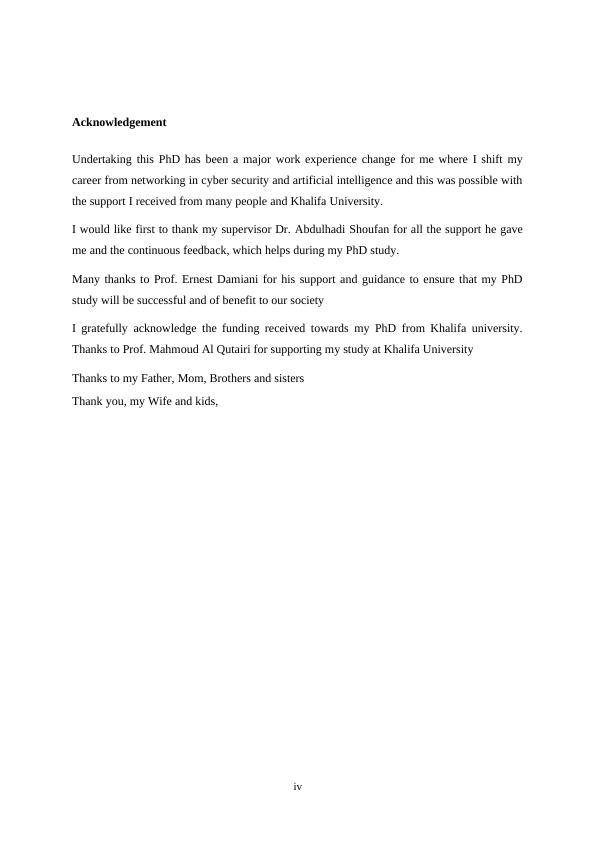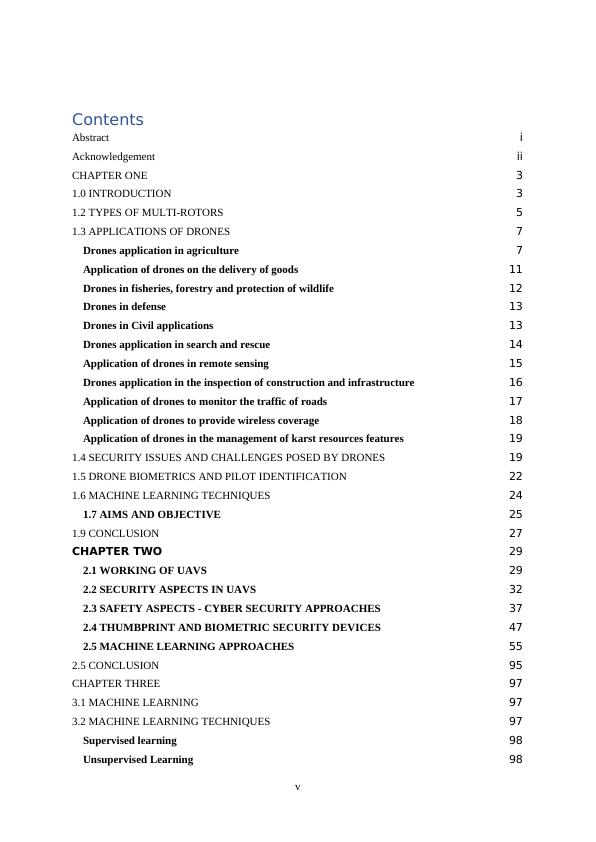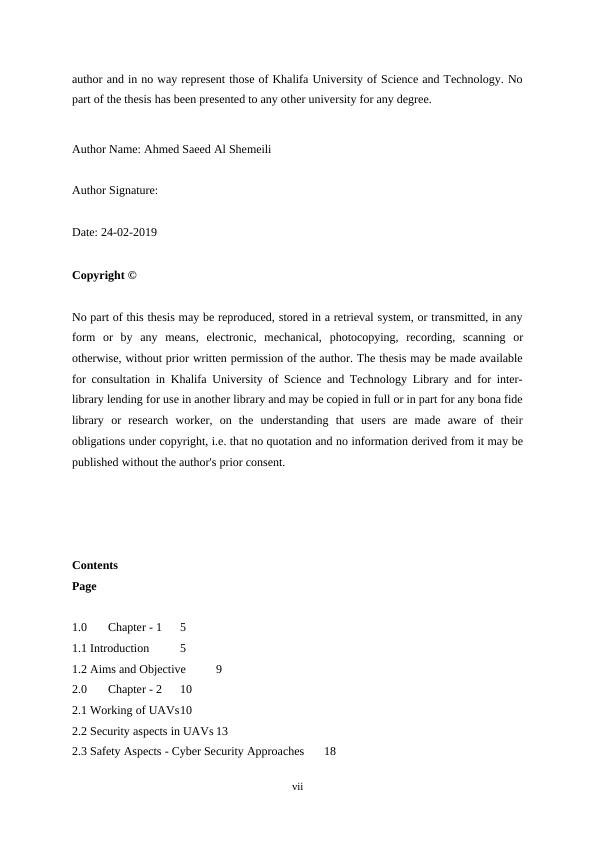Unmanned Aircraft Vehicle (UAV) Pilot Identification Using Machine Learning
194 Pages37026 Words218 Views
Added on 2022-11-29
About This Document
This PhD thesis explores the use of machine learning to identify UAV pilots based on behavioral data. The study aims to develop a model that can recognize individual pilots to prevent unauthorized use of drones. The thesis includes an analysis of different features and classifiers, with promising results in pilot identification accuracy. The research was conducted at Khalifa University of Science and Technology in the United Arab Emirates.
Unmanned Aircraft Vehicle (UAV) Pilot Identification Using Machine Learning
Added on 2022-11-29
ShareRelated Documents
Unmanned Aircraft Vehicle (UAV) Pilot Identification Using Machine Learning
Ahmed Saeed Al Shemeili
PhD. Thesis
February 2019
A thesis submitted to Khalifa University of Science and Technology in accordance with the
requirements of the degree of PhD in Engineering in the Department of (Electrical and
Computer Engineering).
i
Ahmed Saeed Al Shemeili
PhD. Thesis
February 2019
A thesis submitted to Khalifa University of Science and Technology in accordance with the
requirements of the degree of PhD in Engineering in the Department of (Electrical and
Computer Engineering).
i

ii

Abstract
Ahmed Saeed Al Shemeili, “Unmanned Aircraft Vehicle (UAV) Pilot Identification Using
Machine Learning”, PhD Thesis, Program Name, Department of (Electrical and Computer
Engineering), Khalifa University of Science and Technology, United Arab Emirates,
February 2019.
Abstract—the objective is to capture the behavioral data of different pilots while flying the
UAV. Based on that data classification, the algorithm should be able to identify the pilot of
each dataset. 20 datasets were provided, each containing at least 2600 instance (example:
pitch, yaw, thrust, roll, time, pilot, etc.) at different flight modes (triangle, vertical, random).
Trained model will be generated that can identify individual pilot by feeding drone data. This
mechanism will enable the UAV to recognize the pilot in order to avoid being hijacked by
non-authorized pilot.
Drone flight time is not long due to power constrains and this needed to be taken into our
consideration during the design of an online pilot identification model using machine
learning. Machine learning algorithms needs time and power to process and classify datasets.
20 features were tested and classified against 22 classifiers, were Random Forest was selected
as the best classifier. Part of the 20 features comes from Radio Controlled (RC) signal and
from the Internal Measurement Unit (IMU) sensor. Primary results proofed that a single
feature can score an accuracy of 95.9 % in pilot identifications, were the overall performance
of combined features was 99.40%. This new finding will help in enhancing training
/detection time and processing power and memory of our model.
Random forest tree reduction will be evaluated against the generated model; were RF tree
will be examined on how it selects specific pilot for each tree. Objective will be to discover
specific pattern on the distribution of specific trees related to specific pilot and based on this
pattern, we will propose a reduction selection tree route that saves the power and memory for
not being running the data across the whole generated trees (only specific route).
Indexing Terms: UAV, machine learning, random forest, ensemble, bagging, MATLAB
iii
Ahmed Saeed Al Shemeili, “Unmanned Aircraft Vehicle (UAV) Pilot Identification Using
Machine Learning”, PhD Thesis, Program Name, Department of (Electrical and Computer
Engineering), Khalifa University of Science and Technology, United Arab Emirates,
February 2019.
Abstract—the objective is to capture the behavioral data of different pilots while flying the
UAV. Based on that data classification, the algorithm should be able to identify the pilot of
each dataset. 20 datasets were provided, each containing at least 2600 instance (example:
pitch, yaw, thrust, roll, time, pilot, etc.) at different flight modes (triangle, vertical, random).
Trained model will be generated that can identify individual pilot by feeding drone data. This
mechanism will enable the UAV to recognize the pilot in order to avoid being hijacked by
non-authorized pilot.
Drone flight time is not long due to power constrains and this needed to be taken into our
consideration during the design of an online pilot identification model using machine
learning. Machine learning algorithms needs time and power to process and classify datasets.
20 features were tested and classified against 22 classifiers, were Random Forest was selected
as the best classifier. Part of the 20 features comes from Radio Controlled (RC) signal and
from the Internal Measurement Unit (IMU) sensor. Primary results proofed that a single
feature can score an accuracy of 95.9 % in pilot identifications, were the overall performance
of combined features was 99.40%. This new finding will help in enhancing training
/detection time and processing power and memory of our model.
Random forest tree reduction will be evaluated against the generated model; were RF tree
will be examined on how it selects specific pilot for each tree. Objective will be to discover
specific pattern on the distribution of specific trees related to specific pilot and based on this
pattern, we will propose a reduction selection tree route that saves the power and memory for
not being running the data across the whole generated trees (only specific route).
Indexing Terms: UAV, machine learning, random forest, ensemble, bagging, MATLAB
iii

Acknowledgement
Undertaking this PhD has been a major work experience change for me where I shift my
career from networking in cyber security and artificial intelligence and this was possible with
the support I received from many people and Khalifa University.
I would like first to thank my supervisor Dr. Abdulhadi Shoufan for all the support he gave
me and the continuous feedback, which helps during my PhD study.
Many thanks to Prof. Ernest Damiani for his support and guidance to ensure that my PhD
study will be successful and of benefit to our society
I gratefully acknowledge the funding received towards my PhD from Khalifa university.
Thanks to Prof. Mahmoud Al Qutairi for supporting my study at Khalifa University
Thanks to my Father, Mom, Brothers and sisters
Thank you, my Wife and kids,
iv
Undertaking this PhD has been a major work experience change for me where I shift my
career from networking in cyber security and artificial intelligence and this was possible with
the support I received from many people and Khalifa University.
I would like first to thank my supervisor Dr. Abdulhadi Shoufan for all the support he gave
me and the continuous feedback, which helps during my PhD study.
Many thanks to Prof. Ernest Damiani for his support and guidance to ensure that my PhD
study will be successful and of benefit to our society
I gratefully acknowledge the funding received towards my PhD from Khalifa university.
Thanks to Prof. Mahmoud Al Qutairi for supporting my study at Khalifa University
Thanks to my Father, Mom, Brothers and sisters
Thank you, my Wife and kids,
iv

Contents
Abstract i
Acknowledgement ii
CHAPTER ONE 3
1.0 INTRODUCTION 3
1.2 TYPES OF MULTI-ROTORS 5
1.3 APPLICATIONS OF DRONES 7
Drones application in agriculture 7
Application of drones on the delivery of goods 11
Drones in fisheries, forestry and protection of wildlife 12
Drones in defense 13
Drones in Civil applications 13
Drones application in search and rescue 14
Application of drones in remote sensing 15
Drones application in the inspection of construction and infrastructure 16
Application of drones to monitor the traffic of roads 17
Application of drones to provide wireless coverage 18
Application of drones in the management of karst resources features 19
1.4 SECURITY ISSUES AND CHALLENGES POSED BY DRONES 19
1.5 DRONE BIOMETRICS AND PILOT IDENTIFICATION 22
1.6 MACHINE LEARNING TECHNIQUES 24
1.7 AIMS AND OBJECTIVE 25
1.9 CONCLUSION 27
CHAPTER TWO 29
2.1 WORKING OF UAVS 29
2.2 SECURITY ASPECTS IN UAVS 32
2.3 SAFETY ASPECTS - CYBER SECURITY APPROACHES 37
2.4 THUMBPRINT AND BIOMETRIC SECURITY DEVICES 47
2.5 MACHINE LEARNING APPROACHES 55
2.5 CONCLUSION 95
CHAPTER THREE 97
3.1 MACHINE LEARNING 97
3.2 MACHINE LEARNING TECHNIQUES 97
Supervised learning 98
Unsupervised Learning 98
v
Abstract i
Acknowledgement ii
CHAPTER ONE 3
1.0 INTRODUCTION 3
1.2 TYPES OF MULTI-ROTORS 5
1.3 APPLICATIONS OF DRONES 7
Drones application in agriculture 7
Application of drones on the delivery of goods 11
Drones in fisheries, forestry and protection of wildlife 12
Drones in defense 13
Drones in Civil applications 13
Drones application in search and rescue 14
Application of drones in remote sensing 15
Drones application in the inspection of construction and infrastructure 16
Application of drones to monitor the traffic of roads 17
Application of drones to provide wireless coverage 18
Application of drones in the management of karst resources features 19
1.4 SECURITY ISSUES AND CHALLENGES POSED BY DRONES 19
1.5 DRONE BIOMETRICS AND PILOT IDENTIFICATION 22
1.6 MACHINE LEARNING TECHNIQUES 24
1.7 AIMS AND OBJECTIVE 25
1.9 CONCLUSION 27
CHAPTER TWO 29
2.1 WORKING OF UAVS 29
2.2 SECURITY ASPECTS IN UAVS 32
2.3 SAFETY ASPECTS - CYBER SECURITY APPROACHES 37
2.4 THUMBPRINT AND BIOMETRIC SECURITY DEVICES 47
2.5 MACHINE LEARNING APPROACHES 55
2.5 CONCLUSION 95
CHAPTER THREE 97
3.1 MACHINE LEARNING 97
3.2 MACHINE LEARNING TECHNIQUES 97
Supervised learning 98
Unsupervised Learning 98
v

3.3 CLASS IMBALANCE IN MACHINE LEARNING 99
Detect a “naive behavior” 99
Confusion matrix, precision, recall and F1 99
3.4 CRITICAL ANALYSIS 101
3.4.1 Several classifiers for further analysis 102
3.5 CLASSIFICATIONS OF UAV 102
3.6 ARCHITECTURE OF UAV 103
3.7 CYBER PROTECTION OF UAV 108
3.8 RF 114
3.9 SCIENTIFIC PRACTICES 116
3.10 CONCLUSION 116
CHAPTER FOUR 117
4.1 STORAGE OF DATA 117
4.2 DEVICES AND ITS USES 117
4.3 FIVE AVIATORS DATASET 121
4.4 DATA SETS USED 130
4.5 RESULTS 131
4.5.1 RCTriangle = 15156×5 table 138
4.5.2 RCVertical = 10470×5 table 141
4.5.3 CompleteRandom = 54881×21 table 146
4.6 CONCLUSION 167
CHAPTER FIVE 168
5.1 168
CONCLUSION 168
5.1.2 Project Time Plan (to be updated) 170
7.0 REFERENCES 171
Declaration and Copyright
Declaration
I declare that the work in this thesis was carried out in accordance with the regulations of
Khalifa University of Science and Technology. The work is entirely my own except where
indicated by special reference in the text. Any views expressed in the thesis are those of the
vi
Detect a “naive behavior” 99
Confusion matrix, precision, recall and F1 99
3.4 CRITICAL ANALYSIS 101
3.4.1 Several classifiers for further analysis 102
3.5 CLASSIFICATIONS OF UAV 102
3.6 ARCHITECTURE OF UAV 103
3.7 CYBER PROTECTION OF UAV 108
3.8 RF 114
3.9 SCIENTIFIC PRACTICES 116
3.10 CONCLUSION 116
CHAPTER FOUR 117
4.1 STORAGE OF DATA 117
4.2 DEVICES AND ITS USES 117
4.3 FIVE AVIATORS DATASET 121
4.4 DATA SETS USED 130
4.5 RESULTS 131
4.5.1 RCTriangle = 15156×5 table 138
4.5.2 RCVertical = 10470×5 table 141
4.5.3 CompleteRandom = 54881×21 table 146
4.6 CONCLUSION 167
CHAPTER FIVE 168
5.1 168
CONCLUSION 168
5.1.2 Project Time Plan (to be updated) 170
7.0 REFERENCES 171
Declaration and Copyright
Declaration
I declare that the work in this thesis was carried out in accordance with the regulations of
Khalifa University of Science and Technology. The work is entirely my own except where
indicated by special reference in the text. Any views expressed in the thesis are those of the
vi

author and in no way represent those of Khalifa University of Science and Technology. No
part of the thesis has been presented to any other university for any degree.
Author Name: Ahmed Saeed Al Shemeili
Author Signature:
Date: 24-02-2019
Copyright ©
No part of this thesis may be reproduced, stored in a retrieval system, or transmitted, in any
form or by any means, electronic, mechanical, photocopying, recording, scanning or
otherwise, without prior written permission of the author. The thesis may be made available
for consultation in Khalifa University of Science and Technology Library and for inter-
library lending for use in another library and may be copied in full or in part for any bona fide
library or research worker, on the understanding that users are made aware of their
obligations under copyright, i.e. that no quotation and no information derived from it may be
published without the author's prior consent.
Contents
Page
1.0 Chapter - 1 5
1.1 Introduction 5
1.2 Aims and Objective 9
2.0 Chapter - 2 10
2.1 Working of UAVs10
2.2 Security aspects in UAVs 13
2.3 Safety Aspects - Cyber Security Approaches 18
vii
part of the thesis has been presented to any other university for any degree.
Author Name: Ahmed Saeed Al Shemeili
Author Signature:
Date: 24-02-2019
Copyright ©
No part of this thesis may be reproduced, stored in a retrieval system, or transmitted, in any
form or by any means, electronic, mechanical, photocopying, recording, scanning or
otherwise, without prior written permission of the author. The thesis may be made available
for consultation in Khalifa University of Science and Technology Library and for inter-
library lending for use in another library and may be copied in full or in part for any bona fide
library or research worker, on the understanding that users are made aware of their
obligations under copyright, i.e. that no quotation and no information derived from it may be
published without the author's prior consent.
Contents
Page
1.0 Chapter - 1 5
1.1 Introduction 5
1.2 Aims and Objective 9
2.0 Chapter - 2 10
2.1 Working of UAVs10
2.2 Security aspects in UAVs 13
2.3 Safety Aspects - Cyber Security Approaches 18
vii

2.4 Thumbprint and biometric security devices 29
2.5 Machine Learning Approaches 36
3.0 Chapter - 3 77
3.1 Classifications of UAV 77
3.2 Architecture of UAV 77
3.3 Cyber protection of UAV 82
3.4 RF 88
3.5 Scientific practices 89
3.6 Machine Learning 90
3.7 Machine Learning Techniques 90
Supervised learning 91
Unsupervised Learning 91
3.8 Class Imbalance in Machine Learning 92
Detect a “naive behavior” 92
Confusion matrix, precision, recall and F1 92
3.9 Critical Analysis 94
3.10 A few classifiers for further analysis 95
4.0 Chapter - 4 96
4.1 Data Sets Used 109
4.2 Results 110
4.3 RC Triangle = 15156×5 table 119
4.4 RC Vertical = 10470×5 table 124
4.5 Complete Random = 54881×21 table 130
5.0 Chapter - 5 154
5.1 Conclusion 154
References 156
List of Figures
Figure 1. Typical UAV Communication Scenario27
Figure 2. Simple UAV block diagram31
Figure 3. UAV Communication Model31
viii
2.5 Machine Learning Approaches 36
3.0 Chapter - 3 77
3.1 Classifications of UAV 77
3.2 Architecture of UAV 77
3.3 Cyber protection of UAV 82
3.4 RF 88
3.5 Scientific practices 89
3.6 Machine Learning 90
3.7 Machine Learning Techniques 90
Supervised learning 91
Unsupervised Learning 91
3.8 Class Imbalance in Machine Learning 92
Detect a “naive behavior” 92
Confusion matrix, precision, recall and F1 92
3.9 Critical Analysis 94
3.10 A few classifiers for further analysis 95
4.0 Chapter - 4 96
4.1 Data Sets Used 109
4.2 Results 110
4.3 RC Triangle = 15156×5 table 119
4.4 RC Vertical = 10470×5 table 124
4.5 Complete Random = 54881×21 table 130
5.0 Chapter - 5 154
5.1 Conclusion 154
References 156
List of Figures
Figure 1. Typical UAV Communication Scenario27
Figure 2. Simple UAV block diagram31
Figure 3. UAV Communication Model31
viii

End of preview
Want to access all the pages? Upload your documents or become a member.
Related Documents
Unmanned Aircraft Vehicle (UAV) Pilot Identification Using Machine Learninglg...
|226
|35609
|139
Unmanned Aircraft Vehicle (UAV) Pilot Identification Using Machine Learninglg...
|32
|6106
|32
Unmanned Aircraft Vehicle (UAV) Pilot Identification Using Machine Learninglg...
|184
|30717
|50
